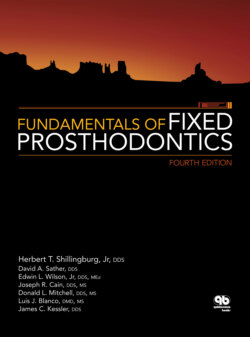Читать книгу Fundamentals of Fixed Prosthodontics - James C. Kessler - Страница 22
На сайте Литреса книга снята с продажи.
TMJ and occlusal evaluation
ОглавлениеPrior to the start of fixed prosthodontics procedures, the patient’s occlusion and TMJs must be evaluated to determine if they are healthy enough to allow the fabrication of restorations. If the occlusion and TMJs are within normal limits, then treatment should be designed to maintain that relationship. However, if the occlusion or one or both TMJs are dysfunctional in some manner, further appraisal is necessary to determine determine whether the dysfunction can be improved prior to the placement of the restorations or if restorations should not be placed.
Fig 1-7 The joints are palpated as the patient opens and closes to detect signs of dysfunction.
Does the patient suffer from frequent occasions of head, neck, or shoulder pain? If so, an attempt must be made to determine the origin of such pain. It may be referred pain, ie, it may not originate from the area where the pain is experienced. 42 Many patients suffer from undiagnosed muscle and/or joint dysfunction of the head and neck region; such a history should be investigated further.
Next, an assessment of the TMJs themselves should be performed. Healthy TMJs function with no evidence of pain. Asymptomatic clicking or crepitation occurs in about one-third of the general population.43 Limitation of movement on opening, closing, or moving laterally should be investigated further to determine the condition of the TMJs. Palpation of the joints as the patient opens and closes should reveal the existence of any signs of dysfunction (Fig 1-7). Many patients suffer from muscle pain as a result of parafunctional jaw activity related to stress. Habits such as clenching the teeth and manipulating the bite during the course of the daily routine may result in fatigue and muscle pain. The physical appearance and activities of the patient should be observed for signs of such habits. Many times they will have a squarejowled appearance, with masseter muscles that are overdeveloped from hyperactivity. They may even clench their teeth during the patient interview.
A brief palpation of the masseter (Fig 1-8), temporalis (Fig 1-9), medial pterygoid (Fig 1-10), trapezius (Fig 1-11), and sternocleidomastoid (Fig 1-12) muscles may reveal tenderness. The patient may demonstrate limited opening due to tightness of the masseter, temporalis, and/or medial pterygoid muscles. This can be noted by asking the patient to open “all the way” (Fig 1-13). If it appears that the opening is limited or the movement is slowed, ask the patient to point to the area that hurts (Fig 1-14). If the patient touches a muscle area, as opposed to the TMJ, there is probably some dysfunction of the neuromuscular system. Patients experiencing a problem with one or both TMJs will most frequency point to the joint itself.
Fig 1-8 The masseter muscles are palpated extraorally by placing the fingers over the lateral surfaces of the rami of the mandible.
Fig 1-9 The fingers are placed over the patient’s temples to feel the temporalis muscles.
Fig 1-10 The index finger is used to touch the medial pterygoid muscle on the inner surface of the ramus.
Fig 1-11 The trapezius muscle is felt at the base of the skull, high on the neck.
Fig 1-12 The sternocleidomastoid muscle is grasped between the thumb and forefingers on the side of the neck. The muscle can be accentuated by a slight turn of the patient’s head.
Fig 1-13 (a) The distance between the maxillary and mandibular incisors is measured when the patient is instructed to open “all the way.” (b) If the patient can only open partially, or opens very slowly, the cause should be determined.
Fig 1-14 If opening is limited or painful, the patient should be instructed to use a finger to indicate the area that hurts.
Evidence of pain or dysfunction in either the TMJs or the muscles associated with the head and neck region is an indication for further evaluation prior to starting any fixed prosthodontics procedures.
